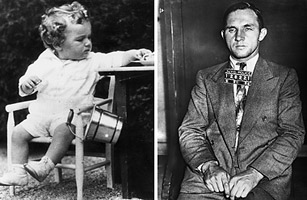
On a winter's night 75 years ago, a child was stolen out of a house in New Jersey. He was no ordinary infant but the "Eaglet," the 20-month-old son of the aviator Charles Lindbergh, America's great hero who, just five years before, had become the first man to fly solo across the Atlantic Ocean. For the next two and a half months, America and much of the world were riveted by daily updates and speculation from the police search for baby Charles. Suspicion spared no one — not even the Lindberghs. In April, news spread that a ransom had been paid but still no child was recovered.
Finally, in May, a battered, mutilated little corpse was found by the side of the road, not far from the Lindberghs' home. Baby Charles had been bludgeoned to death not long after he had been kidnapped. The resulting trial, sentencing and execution of German carpenter and ex-convict Bruno Richard Hauptmann for the crime would extend the infamy of the case four more years. But the Lindbergh kidnapping had become more than just a particularly heinous act. It had become the Crime of the Century. Many other crimes have earned the distinction — but what makes an infamous event deserving of the title Crime of the Century?
TIME has put together its list of notorious crimes that might vie for that distinction. You may notice that there are no political assassinations on the list. Nor mass suicides or genocide. All of those are certainly terrible crimes and possibly even graver sins. But there is a degree of conscious orchestration to those acts. The Crime of the Century must strike at the most undefined and thus most vulnerable part of the soul: it must touch the messy unconscious, where all kinds of emotions meld into each other. Pity and envy are involved; desire and revulsion; fear and sometimes schadenfreude. And while each person has his or her own brew of emotions, we all recognize them. So our fascination with the crime becomes a populist mania: an obsession with the wreckage of the rich and famous, comeuppance for hubris, a communal grasping for a moral to a sordid tale. These horrible disruptions of ordinary life must be able to function as a way to order our most frightening thoughts, becoming cautions and lessons for the future.
Which of the 25 crimes we have selected will remain in the popular, perhaps even the artistic, imagination in the years to come? How will they be retold and with what kinds of lessons and cautions in mind? Here's our selection. How do you think they will fare?